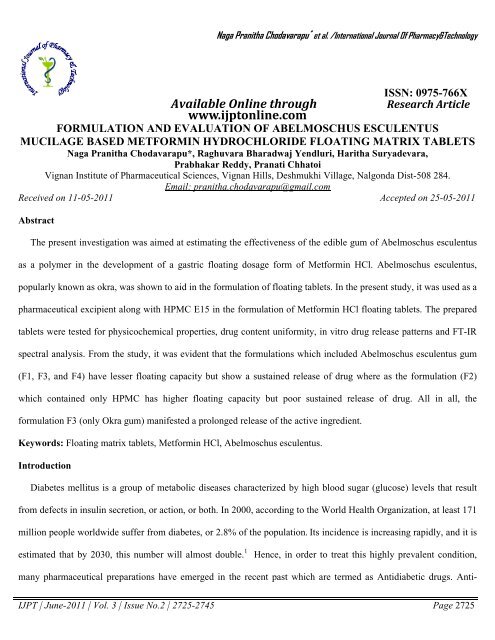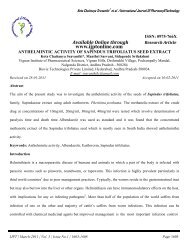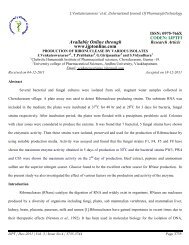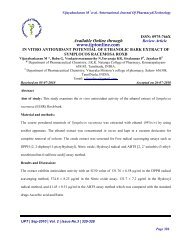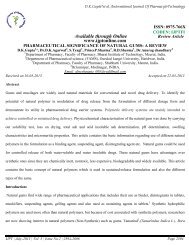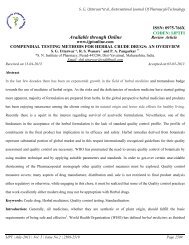Available Online through - International Journal of Pharmacy and ...
Available Online through - International Journal of Pharmacy and ...
Available Online through - International Journal of Pharmacy and ...
You also want an ePaper? Increase the reach of your titles
YUMPU automatically turns print PDFs into web optimized ePapers that Google loves.
Naga Pranitha Chodavarapu * et al. /<strong>International</strong> <strong>Journal</strong> Of <strong>Pharmacy</strong>&Technology<br />
ISSN: 0975-766X<br />
<strong>Available</strong> <strong>Online</strong> <strong>through</strong><br />
Research Article<br />
www.ijptonline.com<br />
FORMULATION AND EVALUATION OF ABELMOSCHUS ESCULENTUS<br />
MUCILAGE BASED METFORMIN HYDROCHLORIDE FLOATING MATRIX TABLETS<br />
Naga Pranitha Chodavarapu*, Raghuvara Bharadwaj Yendluri, Haritha Suryadevara,<br />
Prabhakar Reddy, Pranati Chhatoi<br />
Vignan Institute <strong>of</strong> Pharmaceutical Sciences, Vignan Hills, Deshmukhi Village, Nalgonda Dist-508 284.<br />
Email: pranitha.chodavarapu@gmail.com<br />
Received on 11-05-2011 Accepted on 25-05-2011<br />
Abstract<br />
The present investigation was aimed at estimating the effectiveness <strong>of</strong> the edible gum <strong>of</strong> Abelmoschus esculentus<br />
as a polymer in the development <strong>of</strong> a gastric floating dosage form <strong>of</strong> Metformin HCl. Abelmoschus esculentus,<br />
popularly known as okra, was shown to aid in the formulation <strong>of</strong> floating tablets. In the present study, it was used as a<br />
pharmaceutical excipient along with HPMC E15 in the formulation <strong>of</strong> Metformin HCl floating tablets. The prepared<br />
tablets were tested for physicochemical properties, drug content uniformity, in vitro drug release patterns <strong>and</strong> FT-IR<br />
spectral analysis. From the study, it was evident that the formulations which included Abelmoschus esculentus gum<br />
(F1, F3, <strong>and</strong> F4) have lesser floating capacity but show a sustained release <strong>of</strong> drug where as the formulation (F2)<br />
which contained only HPMC has higher floating capacity but poor sustained release <strong>of</strong> drug. All in all, the<br />
formulation F3 (only Okra gum) manifested a prolonged release <strong>of</strong> the active ingredient.<br />
Keywords: Floating matrix tablets, Metformin HCl, Abelmoschus esculentus.<br />
Introduction<br />
Diabetes mellitus is a group <strong>of</strong> metabolic diseases characterized by high blood sugar (glucose) levels that result<br />
from defects in insulin secretion, or action, or both. In 2000, according to the World Health Organization, at least 171<br />
million people worldwide suffer from diabetes, or 2.8% <strong>of</strong> the population. Its incidence is increasing rapidly, <strong>and</strong> it is<br />
estimated that by 2030, this number will almost double. 1 Hence, in order to treat this highly prevalent condition,<br />
many pharmaceutical preparations have emerged in the recent past which are termed as Antidiabetic drugs. Anti-<br />
IJPT | June-2011 | Vol. 3 | Issue No.2 | 2725-2745 Page 2725
Naga Pranitha Chodavarapu * et al. /<strong>International</strong> <strong>Journal</strong> Of <strong>Pharmacy</strong>&Technology<br />
diabetic medications treat diabetes mellitus by lowering glucose levels in the blood. With the exceptions <strong>of</strong> insulin,<br />
exenatide, <strong>and</strong> pramlintide, all are administered orally <strong>and</strong> are thus also called oral hypoglycemic agents or oral<br />
antihyperglycemic agents. There are different classes <strong>of</strong> anti-diabetic drugs like sulfonyl ureas, meglitinides,<br />
biguanides, thiazolidinediones, alpha-glucosidase inhibitors, peptide analogues to mention a few. The selection <strong>of</strong><br />
drug depends on the nature <strong>of</strong> the diabetes, age <strong>and</strong> situation <strong>of</strong> the person, as well as other factors. 2 Of those drugs,<br />
Metformin Hydrochloride which comes under the class <strong>of</strong> Biguanides, is the most widely used antidiabetic agent<br />
which has got widespread use globally.<br />
Gastric emptying <strong>of</strong> dosage forms is an extremely variable process <strong>and</strong> ability to prolong <strong>and</strong> control the emptying<br />
time is a valuable asset for dosage forms, which reside in the stomach for a longer period <strong>of</strong> time than conventional<br />
dosage forms. Several difficulties are faced in designing controlled release systems for better absorption <strong>and</strong><br />
enhanced bioavailability. One <strong>of</strong> such difficulties is the inability to confine the dosage form in the desired area <strong>of</strong> the<br />
gastrointestinal tract. Drug absorption from the gastrointestinal tract is a complex procedure <strong>and</strong> is subject to many<br />
variables. It is widely acknowledged that the extent <strong>of</strong> gastrointestinal tract drug absorption is related to contact time<br />
with the small intestinal mucosa. 3 Thus, small intestinal transit time is an important parameter for drugs that are<br />
incompletely absorbed.<br />
The controlled gastric retention <strong>of</strong> solid dosage forms may be achieved by the mechanisms <strong>of</strong> mucoadhesion, 4<br />
floatation, 5 sedimentation, 6 expansion, 7 modified shape systems, 8 or by the simultaneous administration <strong>of</strong><br />
pharmacological agents 9 that delay gastric emptying.<br />
In the present investigation, with the incorporation <strong>of</strong> the mucilage extracted from the pods <strong>of</strong> Abelmoshus<br />
esculentus, its efficiency in the formulation <strong>of</strong> Metformin HCl floating tablets has been demonstrated.<br />
Materials <strong>and</strong> Methods<br />
Metformin HCl was a gift sample from Glenmark Pharmaceuticals; while HPMC E 15, Sodium bicarbonate, Citric<br />
acid, Magnesium stearate, Talc were purchased from S.d.Fine Chem., Hyderabad. Fresh Okra pods (Abelmoschus<br />
esculentus) were obtained from local market.<br />
IJPT | June-2011 | Vol. 3 | Issue No.2 | 2725-2745 Page 2726
Naga Pranitha Chodavarapu * et al. /<strong>International</strong> <strong>Journal</strong> Of <strong>Pharmacy</strong>&Technology<br />
Extraction <strong>of</strong> ‘Abelmoschus esculentus’ fruit mucilage 10 : About 2kg <strong>of</strong> fresh immature fruit <strong>of</strong> Abelmoschus<br />
esculentus were obtained from a local market. After removal <strong>of</strong> the seeds, the fresh immature fruits were sliced,<br />
homogenized <strong>and</strong> extracted with cold water containing 1% (w/v) sodium metabisulphate. The crude mucilage was<br />
centrifuged at 3000 rpm for 5 min <strong>and</strong> the gum was precipitated from the supernatant with acetone. The precipitated<br />
gum was washed several times with acetone; the obtained cream coloured product was dried under vacuum in a<br />
desiccator. A light brown coloured powder was obtained after complete removal <strong>of</strong> moisture. The dried gum was<br />
pulverized using end runner mill <strong>and</strong> screened <strong>through</strong> a 0.25 mm stainless steel sieve. This was stored in a well<br />
closed amber colored specimen bottle till ready for use. The yield <strong>of</strong> crude Abelmoschus esculentus mucilage was 10<br />
g /kg immature fruits.<br />
Formulation <strong>and</strong> Evaluation <strong>of</strong> Metformin HCl floating matrix tablets 11 :<br />
By Wet Granulation Method<br />
Metformin HC1, sodium bicarbonate <strong>and</strong> citric acid were passed <strong>through</strong> # 40 sieve <strong>and</strong> mixed with<br />
hydroxypropyl methylcellulose E 15 by geometric mixing. The blend was granulated using distilled water as a<br />
granulation agent. The prepared mass was passed <strong>through</strong> # 20 <strong>and</strong> lubricated with magnesium stearate <strong>and</strong> talc. The<br />
lubricated blend was compressed on rotary tablet press.<br />
Table-1: Composition <strong>of</strong> different formulations.<br />
INGREDIENT F 1<br />
F 2<br />
F 3<br />
F 4<br />
(mg)<br />
(mg) (mg) (mg)<br />
Metformin HCl 500 500 500 500<br />
Abelmoschus esculentus 250 - 200 175<br />
HPMC E 15 - 250 50 75<br />
Distilled water q.s. q.s. q.s. q.s.<br />
Sodium Bicarbonate 200 200 200 200<br />
Citric Acid 10 10 10 10<br />
Magnesium Stearate 5 5 5 5<br />
Talc 5 5 5 5<br />
Average Weight 970 970 970 970<br />
IJPT | June-2011 | Vol. 3 | Issue No.2 | 2725-2745 Page 2727
Naga Pranitha Chodavarapu * et al. /<strong>International</strong> <strong>Journal</strong> Of <strong>Pharmacy</strong>&Technology<br />
Evaluation <strong>of</strong> extracted Okra mucilage:<br />
Phytochemical Examination: Preliminary tests were performed to confirm the nature <strong>of</strong> mucilage obtained. The<br />
chemical tests that were conducted are: Ruthenium red test, Molisch test, test for reducing sugars <strong>and</strong> Ninhydrin<br />
test. 10<br />
Physicochemical parameters<br />
The mucilage was evaluated for solubility, swelling index, loss on drying, density, <strong>and</strong> angle <strong>of</strong> repose as per the<br />
procedures described in IP <strong>and</strong> BP.<br />
Density The bulk volume was determined by recording the volume occupied by a 50 g sample introduced in a 100 ml<br />
measuring cylinder.<br />
Angle <strong>of</strong> repose A funnel <strong>of</strong> 0.8 <strong>and</strong> 8 cm in orifice <strong>and</strong> surface diameters respectively, was used, adopting the<br />
method <strong>of</strong> fixed funnel <strong>and</strong> free st<strong>and</strong>ing cone. A 50 g sample was allowed to flow <strong>through</strong> the funnel to form a cone.<br />
A cathetometer was used to determine the height <strong>of</strong> the heap (h). The base <strong>of</strong> the cone was traced out using a pencil<br />
<strong>and</strong> its radius (r) determined. The angle <strong>of</strong> repose was determined from the following relationship:<br />
Tan e = h/R. 12<br />
Swelling index One tablet was weighed <strong>and</strong> placed in a beaker containing 200 ml <strong>of</strong> distilled water. After each hour<br />
the tablet was removed from beaker <strong>and</strong> weighed again upto 5 hours. The % weight gain by the tablet was calculated<br />
by the formula,<br />
Swelling Index (S.I.) = {(Wt‐Wo)/Wo} ×100 Where, S.I. = swelling index.,Wt = weight <strong>of</strong> tablet at time t. Wo =<br />
weight <strong>of</strong> tablet before immersion. 13<br />
Evaluation <strong>of</strong> Metformin HCl floating tablets:<br />
Tablet Hardness Testing<br />
Tablet requires a certain amount <strong>of</strong> strength or hardness <strong>and</strong> resistance to friability to withst<strong>and</strong> mechanical shakes<br />
<strong>of</strong> h<strong>and</strong>ling in manufacture, packaging <strong>and</strong> shipping. Hardness generally measures the tablet crushing strength. The<br />
hardness <strong>of</strong> the so formulated tablets was tested by using Monsanto hardness tester by holding one tablet between the<br />
IJPT | June-2011 | Vol. 3 | Issue No.2 | 2725-2745 Page 2728
Naga Pranitha Chodavarapu * et al. /<strong>International</strong> <strong>Journal</strong> Of <strong>Pharmacy</strong>&Technology<br />
two faces provided by pushing forward the movable face inside by turning the plunger clockwise. The ‘Zero’ in the<br />
scale was coincided with the pointer. The front part is enclosed where tablet is held in a sample polybag. Pressure<br />
was applied on the tablet by gently rotating the plunger. When the tablet breaks, the hardness (in kg/sq.cm.) directly<br />
from the scale was noted. This was repeated for accurate results <strong>and</strong> the same procedure was followed for every type<br />
<strong>of</strong> formulation. 14<br />
Weight Variation Test (U.S.P.)<br />
20 tablets were weighed individually <strong>and</strong> the average weight was calculated. The individual tablet weight was<br />
compared to the average. The tablet pass the U.S.P. test if no more that 2 tablets are outside the percentage limit <strong>and</strong><br />
if no tablet differs by more than 2 times the percentage limit. 12<br />
Thickness<br />
Tablet thickness is important for tablet packaging. The tablet thickness was determined with the help <strong>of</strong><br />
micrometer.<br />
Friability Test<br />
The weight <strong>of</strong> 20 tablets selected from each batch at r<strong>and</strong>om was determined collectively as initial weight. The<br />
tablets were placed in a friabilator set to rotate at 25 rpm for 4 min. At the end <strong>of</strong> the run, the tablets were de-dusted<br />
<strong>and</strong> weighed <strong>and</strong> Friability was calculated. 12<br />
Drug content uniformity<br />
For drug content uniformity, 20 tablets were weight <strong>and</strong> crushed. An accurately weighed 0.05 g drug equivalent<br />
powder was transferred to 100 ml <strong>of</strong> 0.1 N HCl. This suspension was stirred on a magnetic stirrer for 5 h. The<br />
suspension was then filtered <strong>and</strong> the drug content was determined at 233 nm by making suitable dilutions. 15<br />
Plate.1.Plate showing some <strong>of</strong> the formulations before subjecting to weight variation test<br />
IJPT | June-2011 | Vol. 3 | Issue No.2 | 2725-2745 Page 2729
Naga Pranitha Chodavarapu * et al. /<strong>International</strong> <strong>Journal</strong> Of <strong>Pharmacy</strong>&Technology<br />
In vitro Disintegration Test (U.S.P.)<br />
The U.S.P. device to test disintegration uses 6 glass tubes that are 3” long; open at the top <strong>and</strong> 10 mesh screen at<br />
the bottom end. To test for disintegration time, one tablet was placed in each tube <strong>and</strong> the basket rack was positioned<br />
in a 1-L beaker <strong>of</strong> 0.1 N Hydrochloric acid at 37 ± 20 C such that the tablet remain 2.5 cm below the surface <strong>of</strong> liquid<br />
on their upward movement <strong>and</strong> not closer than 2.5 cm from the bottom <strong>of</strong> the beaker in their downward movement.<br />
The basket containing the tablets was moved up <strong>and</strong> down <strong>through</strong> a distance <strong>of</strong> 5-6 cm at a frequency <strong>of</strong> 28 to 32<br />
cycles per minute. Floating <strong>of</strong> the tablets can be prevented by placing perforated plastic discs on each tablet.<br />
According to the test, the tablet must disintegrate <strong>and</strong> all particles must pass <strong>through</strong> the 10 mesh screen in the time<br />
specified. If any residue remains, it must have a s<strong>of</strong>t mass.<br />
In Vitro Buoyancy Studies:<br />
The in vitro buoyancy was determined by floating lag time, per the method described by Rosa et al. The tables<br />
were placed in a 100-mL beaker containing 0.1N HCL. The time required for the tablet to rise to the surface <strong>and</strong> float<br />
was determined as floating lag time. 16<br />
In Vitro Dissolution Pr<strong>of</strong>ile Studies:<br />
The rate <strong>of</strong> metformin hydrochloride release from metformin hydrochloride sustained release tablets was<br />
conducted using Dissolution Testing Apparatus II (Paddle method). The dissolution test was carried out using 900 ml<br />
<strong>of</strong> 0.1 N HCI, at 37 ± 0.5 Celsius <strong>and</strong> 75 rpm. A sample (10 ml) <strong>of</strong> the solution was withdrawn from the dissolution<br />
apparatus at every hour up to eight hours <strong>and</strong> withdrawn volume was replaced with fresh dissolution media. The<br />
samples were filtered <strong>through</strong> a 0.45 µ membrane filter, the sample was diluted to suitable concentration with 0.1N<br />
HCl. Absorbance <strong>of</strong> these solutions was measured at 233nm using UV spectrophotometer. 11<br />
IJPT | June-2011 | Vol. 3 | Issue No.2 | 2725-2745 Page 2730
Naga Pranitha Chodavarapu * et al. /<strong>International</strong> <strong>Journal</strong> Of <strong>Pharmacy</strong>&Technology<br />
Plate.2. Dissolution test apparatus (II)<br />
Plotting St<strong>and</strong>ard curve <strong>of</strong> Metformin HCl<br />
Preparation <strong>of</strong> buffer (0.1 N HCl)<br />
8.5 ml <strong>of</strong> concentrated Hydrochloric acid was diluted to 1000 ml <strong>of</strong> distilled water to obtain a concentration <strong>of</strong><br />
0.1N HCl. It was then tested for pH using pH meter. 17<br />
Preparation <strong>of</strong> Stock Solution<br />
10 mg <strong>of</strong> Metformin HCl was dissolved in small quantity <strong>of</strong> 0.1N HCl <strong>and</strong> made up to 100 ml using 0.1N HCl<br />
which is the Stock solution. From this solution, 0.2ml was taken <strong>and</strong> dissolved in 10 ml <strong>of</strong> distilled water to obtain a<br />
concentration <strong>of</strong> 2 mcg/ml. Similarly, other concentrations were made.<br />
Drug Release Patterns<br />
The extent at which the drug releases from the tablet was calculated from the st<strong>and</strong>ard graph <strong>of</strong> Metformin HCl.<br />
Similarly, the drug release patterns <strong>of</strong> all the formulations were determined. The extent <strong>of</strong> drug release was estimated<br />
by plotting a graph <strong>of</strong> time versus percent cumulative drug release.<br />
Plate.3.UV-Spectrophotometer<br />
IJPT | June-2011 | Vol. 3 | Issue No.2 | 2725-2745 Page 2731
FT-IR Spectral Analysis<br />
Naga Pranitha Chodavarapu * et al. /<strong>International</strong> <strong>Journal</strong> Of <strong>Pharmacy</strong>&Technology<br />
Infrared spectroscopy is one <strong>of</strong> the most powerful analytical techniques, which <strong>of</strong>fers the possible chemical<br />
interaction between drug <strong>and</strong> excipients used. In the present work, IR spectra <strong>of</strong> floating tablets <strong>of</strong> Metformin HCl<br />
were determined using FT-IR spectrophotometer at STARTECH LABS, Hyderabad due to lack <strong>of</strong> facilities.<br />
RESULTS AND DISCUSSION<br />
Investigational results <strong>of</strong> the extracted mucilage<br />
Phytochemical screening tests: The mucilage that was extracted from the Abelmoschus esculentus fruits showed the<br />
presence <strong>of</strong> high percentage <strong>of</strong> complex polysaccharides along with the presence <strong>of</strong> glucose in small amounts.<br />
Physicochemical parameters<br />
Table-2: Physicochemical parameters.<br />
S. No. Physicochemical parameter Result<br />
1. Swelling ratio 27<br />
2. Solubility slightly soluble in water,<br />
insoluble in ethanol, acetone,<br />
ether <strong>and</strong><br />
chlor<strong>of</strong>orm.<br />
3. Bulk Density (g/cc)<br />
Tapped Density (g/cc)<br />
0.61<br />
0.74<br />
4. Angle <strong>of</strong> Repose 33 0<br />
5. Loss on drying 0.8%<br />
Investigational results <strong>of</strong> the formulated Metformin HCl floating tablets<br />
IJPT | June-2011 | Vol. 3 | Issue No.2 | 2725-2745 Page 2732
Naga Pranitha Chodavarapu * et al. /<strong>International</strong> <strong>Journal</strong> Of <strong>Pharmacy</strong>&Technology<br />
Table-3: Physical properties.<br />
Formulation Weight Hardness Thickness Friability Drug content<br />
variation Kg.cm 2 ± mm ± S.D. (%) % ± S.D.<br />
mg ± S.D S.D. (n=3) (n=5)<br />
(n=20)<br />
(n=20)<br />
F1 967±0.12 5.375±0.13 5.2±0.11 0.59±0.13 99.23±0.12<br />
F2 967.5±0.14 6.5±0.15 4.9±0.13 0.62±0.15 99.42±0.14<br />
F3 966±0.16 5.0±0.17 5.3±0.15 0.61±0.17 99.84±0.16<br />
F4 968±0.18 4.25±0.19 5.2±0.17 0.58±0.19 99.61±0.18<br />
In vitro Tablet Disintegration Test<br />
The disintegration time for each <strong>of</strong> the four formulations is as follows:<br />
Table-4: Disintegration time.<br />
S. No. Formulation Disintegration Time<br />
(in min)<br />
1. F1 118.00<br />
2. F2 7.36<br />
3. F3 56.00<br />
4. F4 25.00<br />
Invitro Buoyancy Studies<br />
The floating times <strong>of</strong> the four formulations is given below:<br />
Table-5: Floating time.<br />
S. No. Formulation Floating Time<br />
1. F1 6 min 25 sec<br />
2. F2 14 sec<br />
3. F3 5 min 49 sec<br />
4. F4 5 min 20 sec<br />
IJPT | June-2011 | Vol. 3 | Issue No.2 | 2725-2745 Page 2733
Naga Pranitha Chodavarapu * et al. /<strong>International</strong> <strong>Journal</strong> Of <strong>Pharmacy</strong>&Technology<br />
Plate.4. Stage 1 in the floating study<br />
Plate.5. Stage 2 in the floating study<br />
Plate.6. Stage 3 in the floating study<br />
IJPT | June-2011 | Vol. 3 | Issue No.2 | 2725-2745 Page 2734
Naga Pranitha Chodavarapu * et al. /<strong>International</strong> <strong>Journal</strong> Of <strong>Pharmacy</strong>&Technology<br />
St<strong>and</strong>ard graph <strong>of</strong> Metformin HCl at = 233 nm.<br />
Table.6.St<strong>and</strong>ard .St<strong>and</strong>ard graph values <strong>of</strong> Metformin<br />
S. No. Concentration (mcg/ml)<br />
Absorbance (nm)<br />
1. 0<br />
0.000 0.0000<br />
2. 2<br />
0.201 0.0012<br />
3. 4<br />
0.404 0.0016<br />
4. 6<br />
0.556 0.0017<br />
5. 8<br />
0.717 0.0016<br />
6. 10<br />
0.988 0.0015<br />
*Each reading is a mean <strong>of</strong> three determinations<br />
1.2<br />
St<strong>and</strong>ard curve<br />
1<br />
0.8<br />
0.6<br />
0.4<br />
St<strong>and</strong>ard curve<br />
0.2<br />
0<br />
2<br />
4 6 8 10<br />
Fig.1. . St<strong>and</strong>ard calibration curve <strong>of</strong> Metformin HCl at = 233 nm.<br />
Table-7: Drug release patterns.<br />
S.No. TIME (min) % cumulative drug released<br />
F1 F2 F3<br />
1. 00<br />
0.000 0.000 0.000<br />
2. 30<br />
0.900 7.938 3.978<br />
3. 60<br />
2.358 17.674 9.846<br />
4. 90<br />
4.608 27.990 16.002<br />
5. 120<br />
8.550 38.934 22.644<br />
F4<br />
0.000<br />
5.850<br />
12.906<br />
20.880<br />
29.376<br />
IJPT | June-2011 | Vol. 3 | Issue No.2 | 2725-2745<br />
Page 2735
6. 150<br />
7. 180<br />
8. 210<br />
9. 240<br />
10. 270<br />
11. 300<br />
12. 330<br />
13. 360<br />
14. 390<br />
15. 420<br />
16. 450<br />
17. 480<br />
Naga Pranitha Chodavarapu * et al. /<strong>International</strong> <strong>Journal</strong> Of <strong>Pharmacy</strong>&Technology<br />
12.978 50.076 29.682 38.034<br />
18.000 61.686 37.062 47.394<br />
23.382 73.674 44.964 56.916<br />
29.232 86.150 53.082 66.816<br />
35.334 99.128 61.578 77.148<br />
41.976 70.776 88.272<br />
48.996 80.190 99.864<br />
56.286 90.522<br />
64.242 99.899<br />
72.792<br />
82.116<br />
91.584<br />
Comparison <strong>of</strong> drug release patterns <strong>of</strong> F1, F2, F3 <strong>and</strong> F4<br />
120<br />
100<br />
80<br />
60<br />
40<br />
20<br />
F1<br />
F2<br />
F3<br />
F4<br />
0<br />
30 60 90 120 150 180 210 240 270 300 330 360 390 420 450 480<br />
Fig.6.Comparison .Comparison <strong>of</strong> drug release patterns<br />
IJPT | June-2011 | Vol. 3 | Issue No.2 | 2725-2745<br />
Page 2736
FT – IR Spectral Analysis<br />
Naga Pranitha Chodavarapu * et al. /<strong>International</strong> <strong>Journal</strong> Of <strong>Pharmacy</strong>&Technology<br />
Fig.7.FT – IR Spectra <strong>of</strong> F1<br />
IJPT | June-2011 | Vol. 3 | Issue No.2 | 2725-2745 Page 2737
Fig.8.FT – IR Spectra <strong>of</strong> F2<br />
Naga Pranitha Chodavarapu * et al. /<strong>International</strong> <strong>Journal</strong> Of <strong>Pharmacy</strong>&Technology<br />
IJPT | June-2011 | Vol. 3 | Issue No.2 | 2725-2745 Page 2738
Naga Pranitha Chodavarapu * et al. /<strong>International</strong> <strong>Journal</strong> Of <strong>Pharmacy</strong>&Technology<br />
Fig.9.FT – IR Spectra <strong>of</strong> F3<br />
Fig.10.FT – IR Spectra <strong>of</strong> F4<br />
IJPT | June-2011 | Vol. 3 | Issue No.2 | 2725-2745 Page 2739
Naga Pranitha Chodavarapu * et al. /<strong>International</strong> <strong>Journal</strong> Of <strong>Pharmacy</strong>&Technology<br />
Characterization <strong>of</strong> the extracted mucilage<br />
IJPT | June-2011 | Vol. 3 | Issue No.2 | 2725-2745 Page 2740
Naga Pranitha Chodavarapu * et al. /<strong>International</strong> <strong>Journal</strong> Of <strong>Pharmacy</strong>&Technology<br />
The extracted <strong>and</strong> purified Ae gum is cream coloured <strong>and</strong> odourless. From the chemical tests, it is clear that the<br />
gum is composed mainly <strong>of</strong> monosaccharide units <strong>of</strong> galactose, rhamnose <strong>and</strong> galacturonic acid. The swelling index,<br />
density (bulk <strong>and</strong> tapped density), loss on drying, solubility <strong>and</strong> angle <strong>of</strong> repose were found to be complying with the<br />
st<strong>and</strong>ards.<br />
Metformin HCl floating tablets<br />
Weight Variation Test<br />
All the tablets were found to comply with the st<strong>and</strong>ards prescribed in the U.S.P., <strong>and</strong> showed no much variation in the<br />
weight <strong>of</strong> the individual tablets.<br />
Tablet Hardness<br />
All the four types <strong>of</strong> formulations (F1, F2, F3, F4) were found to have the required hardness. The formulation, F2 that<br />
contained only HPMC E 15 showed greatest hardness while the formulation, F4 which has a mixture <strong>of</strong> Abelmoschus<br />
esculentus <strong>and</strong> HPMC in the ratio, 2.34:1, showed least hardness. The formulations, F1 <strong>and</strong> F3, showed almost equal<br />
hardness (~5).<br />
Tablet thickness<br />
The thickness <strong>of</strong> all the four types <strong>of</strong> tablets was optimum <strong>and</strong> their results can be found in the Table.3.<br />
Friability<br />
Friability values <strong>of</strong> all the formulations were within the limit i.e. is less than 1.0% indicated that tablets had a good<br />
mechanical strength.<br />
Drug content uniformity<br />
Drug content <strong>of</strong> all the formulations were found to be in the range <strong>of</strong> 98.5 – 101.0%, which is within acceptable<br />
limits. The results are shown in Table.3.<br />
In vitro Tablet Disintegration Test: The formulation, F1 which included only fruit mucilage took more time to<br />
disintegrate while F2 which contained HPMC E 15 took least time to get disintegrated. When the formulations, F3<br />
<strong>and</strong> F4 are considered, which have combination <strong>of</strong> both okra mucilage <strong>and</strong> HPMC, F3 which has the highest<br />
IJPT | June-2011 | Vol. 3 | Issue No.2 | 2725-2745 Page 2741
Naga Pranitha Chodavarapu * et al. /<strong>International</strong> <strong>Journal</strong> Of <strong>Pharmacy</strong>&Technology<br />
percentage <strong>of</strong> fruit mucilage has taken more time to disintegrate when compared to F4, which has lower percentage <strong>of</strong><br />
it. (Table.4.)<br />
In vitro Buoyancy studies<br />
The floating time <strong>of</strong> formulation, F1 is greatest among all the four formulations. On the other h<strong>and</strong>, the formulation,<br />
F2 took very less time to float in the simulated gastric fluids. Likewise, the formulations F3 <strong>and</strong> F4 which contained<br />
HPMC <strong>and</strong> Abelmoschus esculentus fruit mucilage, but in different ratios, showed almost equal floating times (~ 5<br />
min). (Table.5).<br />
In vitro Dissolution pr<strong>of</strong>ile Studies <strong>and</strong> drug release patterns<br />
The in vitro drug release was carried out in 0.1N HCl. For all the formulations(F1, F2, F3, F4), as the time<br />
increased, the dissolution <strong>of</strong> the drug into the simulated gastric fluids also increased which indicates increase in the<br />
concentration <strong>of</strong> drug as the time passes.<br />
At the end <strong>of</strong> 480 min., the percentage amount <strong>of</strong> drug released from F1 was 91.584 <strong>and</strong> this indicates that the<br />
formulation (F1) which has only Ae gum released the drug very slowly. On the other h<strong>and</strong>, the drug from the<br />
formulation, F2 which has only HPMC E 15 was released very rapidly i.e., 99.128% within 270 min., which implies<br />
lesser sustained release in comparison with F1. Similarly, the percentage amount <strong>of</strong> drug released from the<br />
formulations, F3 <strong>and</strong> F4 were 99.899% (after 390 min.) <strong>and</strong> 99.864% (after 330 min.). From these results, it is clear<br />
that the formulation, F1 manifested sustained release <strong>of</strong> the drug, Metformin HCl among all the other formulations.<br />
(Tables: 7 – 10 <strong>and</strong> Figures: 2 – 6).<br />
FT – IR Spectral Analysis<br />
The peaks at 3171/cm., 1062/cm. <strong>and</strong> 1580/cm., show the presence <strong>of</strong> –NH 2, C-N stretching <strong>and</strong> NH groups<br />
respectively. From the FT-IR analysis, it was demonstrated that there was no chemical interaction between the drug<br />
<strong>and</strong> other excipients used in the formulation.<br />
IJPT | June-2011 | Vol. 3 | Issue No.2 | 2725-2745 Page 2742
Conclusion<br />
Naga Pranitha Chodavarapu * et al. /<strong>International</strong> <strong>Journal</strong> Of <strong>Pharmacy</strong>&Technology<br />
• The results from the physicochemical parameters <strong>of</strong> the mucilage manifested all the characteristics <strong>of</strong> a good<br />
pharmaceutical excipient that can be used for the formulation <strong>of</strong> floating tablets. In addition, the swelling ratio<br />
<strong>of</strong> the mucilage is optimum which aids in the floatation <strong>of</strong> the tablet in the gastric fluids.<br />
• From the present investigation, it is quite evident that incorporation <strong>of</strong> Abelmoschus esculentus fruit mucilage<br />
as one <strong>of</strong> the pharmaceutical excipients facilitates controlled release <strong>of</strong> the drug for prolonged time by<br />
maintaining the tablet in a floating condition in the gastric fluids due to the matrix forming capability <strong>of</strong> the<br />
mucilage.<br />
• Abelmoschus gum has swellable property; hence it can be used as a polymer in the development <strong>of</strong> a GRDDS<br />
either singly or in combination with polymers like HPMC. But, the formulation with only Ae gum is very<br />
much acceptable for formulating floating matrix tablets since it showed a sustained release effect for more<br />
period <strong>of</strong> time.<br />
• It can be emphasized that Abelmoschus esculentus gum has shown much more floating capacity accompanied<br />
by sustained release than HPMC E 15 polymer.<br />
• With optimal floating time, the Metformin HCl floating tablets with Ae help in increasing the residence time<br />
<strong>of</strong> Metformin HCl in stomach. This further helps to decrease the frequency <strong>of</strong> dosing; thus minimizing the<br />
side effects caused due to Metformin where it is known to cause damage to the kidneys.<br />
• In addition, since Abelmoschus esculentus gum is easily available <strong>and</strong> the extraction includes very fewer<br />
steps, it is comparatively economical for bulk production <strong>of</strong> the drug.<br />
References<br />
1. Wild S, Roglic G, Green A, Sicree R, King H (May 2004). "Global prevalence <strong>of</strong> diabetes: estimates for 2000<br />
<strong>and</strong> projections for 2030". Diabetes Care 27 (5): 1047–53. doi:10.2337/diacare.27.5.1047. PMID 15111519<br />
2. http://en.wikipedia.org/wiki/Anti-diabetic_medication<br />
IJPT | June-2011 | Vol. 3 | Issue No.2 | 2725-2745 Page 2743
Naga Pranitha Chodavarapu * et al. /<strong>International</strong> <strong>Journal</strong> Of <strong>Pharmacy</strong>&Technology<br />
3. Hirtz J. The git absorption <strong>of</strong> drugs in man: a review <strong>of</strong> current concepts <strong>and</strong> methods <strong>of</strong> investigation. Br J<br />
Clin Pharmacol. 1985; 19:77S-83S.<br />
4. Ponchel G, Irache JM. Specific <strong>and</strong> non-specific bioadhesive particulate system for oral delivery to the<br />
gastrointestinal tract. Adv Drug Del Rev. 34; 1998; 191-219.<br />
5. Deshp<strong>and</strong>e AA, Shah NH, Rhodes CT, Malick W. Development <strong>of</strong> a novel controlled-release system for<br />
gastric retention. Pharm Res.; 14; 1997;815-819.<br />
6. Rednick AB, Tucker SJ, inventors. Sustained release bolus for animal husb<strong>and</strong>ry. US patent 3, 1970; 507 952.<br />
7. Urguhart J, Theeuwes F, inventors. Drug delivery system comprising a reservoir containing a plurality <strong>of</strong> tiny<br />
pills. US patent 4; 1994; 153.<br />
8. Kedzierewicz F, Thouvenot P, Lemut J, Etienne A, H<strong>of</strong>fman M, Maincent P. Evaluation <strong>of</strong> peroral silicone<br />
dosage forms in humans by gamma-scintigraphy. J Control Release. 58; 1999; 195-205.<br />
9. Groning R, Heun G. Oral dosage forms with controlled gastrointestinal transit. Drug Dev Ind Pharm. 10;<br />
1984; 527-539.<br />
10. Ilango K B, Manisha Mishra, In Vitro And In Vivo Evaluation Of Okra Polysaccharide-BasedColon-<br />
Targeted Drug Delivery Systems, <strong>International</strong> <strong>Journal</strong> Of Pharmaceutical Sciences, Volume 5, 2010, 138<br />
11. Ganesh Rajput, Dr. Jayvadan Patel, Development <strong>and</strong> optimization <strong>of</strong> Mteformin HCl gastroretentive tablets,<br />
jpronline.info, 2009.<br />
12. G. C. Onunkwo, Evaluation <strong>of</strong> Okra gum as a binder in the formulation <strong>of</strong> Thiamine HCl tablets <strong>and</strong> granules,<br />
Research in Pharmaceutical Biotechnology Vol. 2(3), 2010, 33-39.<br />
13. R. V. Kshirsagar et al., Effect <strong>of</strong> different viscosity grade HPMC polymers on gastro retentive drug delivery<br />
<strong>of</strong> Metformin HCl, <strong>International</strong> <strong>Journal</strong> <strong>of</strong> Applied Pharmaceutics, Vol 1, Issue !, 2009, 44 -50.<br />
14. Indian Pharmacopoeia, The Indian Pharmacopoeia Commission, Ghaziabad, Vol II, 2007, 2007, 1357-1360.<br />
15. S. I Ofoefule, A Chukwu, Application Of Abelmoschus Esculentus In Solid Dosage Formulation 1: Use As A<br />
Binder For A Poorly Water Soluble Drug, Indian <strong>Journal</strong> <strong>of</strong> Pharmaceutical Sciences, Vol 63, 2001, 234-238.<br />
IJPT | June-2011 | Vol. 3 | Issue No.2 | 2725-2745 Page 2744
Naga Pranitha Chodavarapu * et al. /<strong>International</strong> <strong>Journal</strong> Of <strong>Pharmacy</strong>&Technology<br />
16. Shailesh T. Prajapati, Floating matrix tablets <strong>of</strong> Domperidone-Formulation <strong>and</strong> evaluation, Thai J. Pharm. Sci.<br />
33; 2009; 113-122.<br />
17. Indian Pharmacopoeia, The Indian Pharmacopoeia Commission, Ghaziabad, Vol II, 2007.<br />
18. Loyd V. Allen, Jr., Nicholas G. Popovich, Howard C. Ansel, Pharmaceutical Dosage forms <strong>and</strong> Drug<br />
Delivery systems, Lippincott Williams <strong>and</strong> Wilkins, Eighth edition, 2007, 265-266.<br />
19. Herbert A. Lieberman, Leon Lachman, Joseph B. Schwartz, Pharmaceutical Dosage Forms: Tablets, Vol I,<br />
Marcel Dekker, Inc., 2008, 285-328.<br />
20. Salil K. Bhattacharya, Parantapa Sen, Arunabha Ray, Pharmacology, Elseiver India Pvt. Ltd., New Delhi,<br />
2005, 251-363.<br />
21. Laurence L. Brunton, John S. Lazo, Keith L. Parker, The Pharmacological Basis <strong>of</strong> Therapeutics, Mc Graw<br />
Hill Publishers, 2006, 1613,1619-1625,1638-1639.<br />
22. Remington, the Science <strong>and</strong> Practice <strong>of</strong> <strong>Pharmacy</strong>, Vol II, Lippincott Williams <strong>and</strong> Wilkins, 2006, 1452-1453.<br />
23. N. K. Jain, Progress in Controlled <strong>and</strong> Novel Drug Delivery Systems, CBS Publishers <strong>and</strong> Distributors, New<br />
Delhi, 2008, 76-97.<br />
24. Yie N. Chien, Novel Drug Delivery Systems, Marcel Dekker Inc., Vol 50, 1992, 285-290.<br />
25. Donald L. Wise, H<strong>and</strong>book <strong>of</strong> Pharmaceutical Controlled Release Technology, Marcel Dekker Inc., 2008, 1-<br />
31, 505-526.<br />
26. D. P. S. Kohli, D. H. Shah, Drug Formulations, Eastern Publishers, New Delhi, 2008,101,121.<br />
27. H. P. Rang, M. M. Dale, J. M. Ritter, R. J. Flower, Pharmacology, Churchill Livingstone, Elseiver, 2007,<br />
404,405,408.<br />
28. Gums <strong>and</strong> mucilages: versatile excipients for pharmaceutical formulations Girish K Jania, Dhiren P Shahb,<br />
Vipul D Prajapatia, Vineet C; Accepted 24 September 2009. Asian <strong>Journal</strong> <strong>of</strong> Pharmaceutical Sciences 2009,<br />
4 (5): 309-3233109.<br />
Corresponding Author: Naga Pranitha Chodavarapu*<br />
IJPT | June-2011 | Vol. 3 | Issue No.2 | 2725-2745 Page 2745


